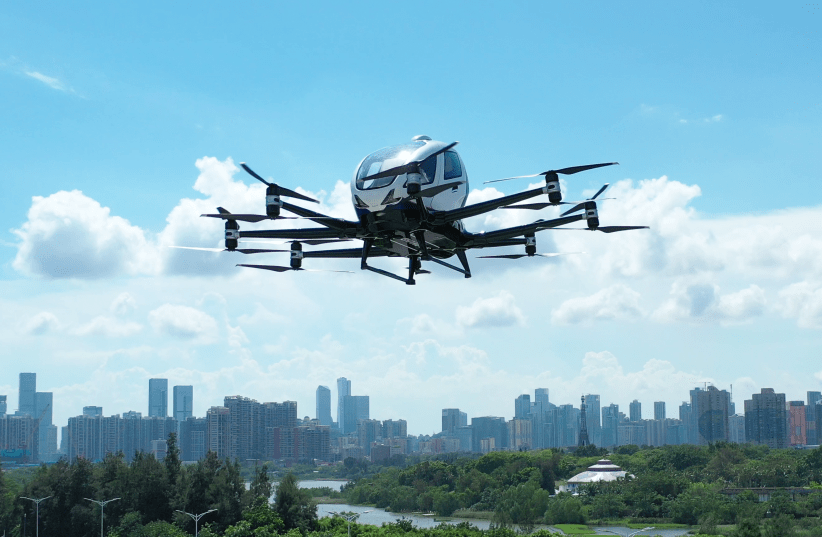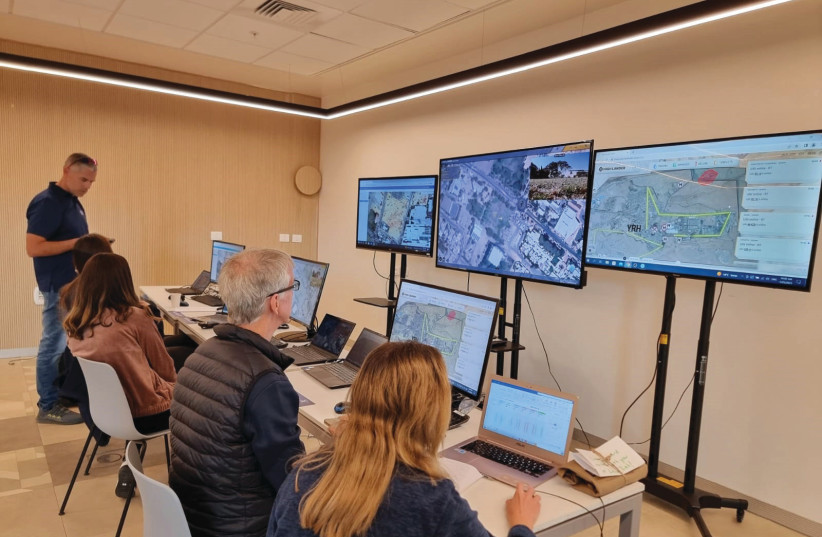Two years ago, The Jerusalem Post reported that Israel would test making pizza deliveries by drone as part of an effort to build a national drone delivery infrastructure. So whatever happened to that?
“The conclusion we came to at the end of that pilot program was that in order to make it work, we had to aim even higher,” said Daniella Partem, who leads the drone project as head of the Israel Innovation Authority’s Center for the Fourth Industrial Revolution. “That’s where we are now with our second phase of the program.”
“The conclusion we came to at the end of that pilot program was that in order to make it work, we had to aim even higher.”
Daniella Partem
To understand what she meant, let’s start at the beginning.
What is Israel's drone initiative and how does pizza fit in?
The National Drone Initiative began in 2020 as a collaboration of the Israel Innovation Authority (IIA); the Transportation Ministry (through the Ayalon Highways Company); the Civil Aviation Authority; and the Smart Transportation Authority.
The goal was to test whether the initiative could create a centrally coordinated network that could track hundreds of autonomous drones making deliveries around the country at the same time. If it would be successful, it could lay the groundwork for a new world in which drones could be used to deliver everything from emergency medical supplies and military gear to takeout food.
“The idea is not to create a singular government-run system but to create an ecosystem with market competition in which multiple companies would manage and deploy their own drone fleets, with everything connected and coordinated through one central network,” Partem explained. The model would be analogous to that of an airport’s traffic control center – each airline operates its own flights independently, but all takeoffs and landings are coordinated through the traffic control tower.
Developing a system that could track and guide hundreds or thousands of autonomous drones operating without human interference presents a variety of complex challenges with a wide range of potential ramifications. The National Drone Initiative’s mission was to see what it would take to make it all work.
“We created a sandbox environment that would allow us to understand the needs and challenges of creating this type of ecosystem on the national level,” Partem said. “As we learned more, we would gain a deeper understanding of the real-world challenges that such a network would face.”
In order to do so, the project team conducted a series of eight missions over the course of two years, each more complicated than the previous one, in order to develop the technology.
In the summer of 2021, Pizza Hut took part in one of the first missions, in which pizzas were delivered by drone from Kfar Yona, a small town near Netanya, to customers in a nearby village. Pizzas were dropped in designated parking lots, where drivers could pick them up and deliver them to customers’ homes.
“If you imagined that a drone would fly directly to your balcony to deliver a package – it’s not going to work exactly that way,” Udi Shamai, CEO of Pizza Hut Israel, explained at the time. “There are too many issues of privacy, noise and safety to have drones buzzing between apartment buildings. The model that makes more sense is that deliveries can be made to assigned drop spots, and then transported by auto for the last mile.”
Several months later, in October 2021, journalists were invited to observe part of the third mission, in which drones, flying over residential areas, delivered orders of sushi, beer and ice cream.
At the Ayalon Highways command center in Tel Aviv, a huge wall full of screens filled with maps, charts and coordinates allowed operators to track the location of dozens of drones flying over the area in real time.
Meanwhile, at the Tzuk Beach several kilometers away, food was ordered from nearby restaurants and delivered by drone. The landing was noisy at the northern Tel Aviv beachside drop spot, but the drones landed exactly on their targets 15 minutes after the order was placed, offering a delivery experience faster than Wolt or 10Bis can offer.
The experiment was progressing quickly, and it began to look like there might be more to this ambitious experiment than just a pie in the sky.
What went wrong?
HOWEVER, MANY logistical, regulatory and economic challenges remained to be resolved, many of them seemingly insurmountable.
“One of the most important things we learned from the trial was that scale was a critical factor to making drone deliveries economically viable,” Partem said.
“In the first phase, we were limited by regulatory authorities to using small drones with payloads of up to 2.5 kilos, which made sense at the time from a safety standpoint. However, that severely limited the commercial viability of our model. The expense for a company to set up a network and deploy a fleet of drones means every drone flight will cost hundreds of shekels, at least in the early stages. That doesn’t work if you are limited to delivering take-out food.”
The two-year trial ended with the conclusion that another two-year project was needed. And this one would have to aim higher and be able to carry heavier loads, including people.
It's time for phase 2
In January this year, IIA announced phase two of the National Drone Initiative, operating on a more intense schedule and using larger drones. With a NIS 60 million investment, 10 private companies were chosen to participate in the program, which includes one week of flights across the country every month over two years, for a total of 24 trials. The program now has the cooperation of the Israel Air Force, Airports Authority and other regulatory entities that weren’t directly involved in the first phase.
The NIS 60m. investment was split 50-50 between government and private financing, noted Hagit Lidor, IIA’s international communications manager. “We never provide 100% of the financing for any project. Everything we do always uses private financing. It is also important to understand that part of the goal of this ecosystem is to create a competitive market. So, for example, for every technology or service we use, we want at least two companies operating.”
In the first demonstration in January, flights made the intercity journey from Dimona to Yeroham in the South, carrying items for delivery. At the same time, other drones undertook a greater challenge, taking off from the Ilan Ramon Airport near Eilat.
“There is a lot of complexity and danger flying drones where airplanes are flying,” Partem noted. “Part of creating this ecosystem is making sure that the systems that manage the drones communicate with the systems managing planes.”
Larger drones are now being used in the pilot program, and that raises new safety challenges.
“As a general rule, the size of a drone’s payload is about 10% of the total weight of the drone,” Partem said. “That means that a passenger drone that can carry 200 kg. – like the ones we have been testing – weighs about two tons. But for vehicles like that, we can’t just land them in open areas or parking lots. Somebody needs to finance and build serious landing sites around the country to support them.”
The ability to adapt to fast-changing regulatory requirements is another critical challenge. Partem noted a new regulation that would require that the police be able to completely close down the airspace over a particular area or limit access to only drones with specific authorization. A national network would need the ability to close off specific coordinates with the press of a button.
There is an endless list of logistical requirements that need to be resolved.
“You need a proof of delivery app to make sure that products are delivered to the right people,” Partem noted. “You need to be able to order drones to change their route if a helicopter enters their airspace. You need to legislate safety requirements for landing zones. And you need everything to make commercial sense for businesses. Otherwise, it won’t work.”
GETTING THE formula right may be difficult, but the potential of a national drone network is vast.
“Besides commercial deliveries, there is the opportunity to save lives by transporting equipment, medicines and people between hospitals,” Partem noted.
The possibilities of developing new modes of human transportation are staggering. The benefits for police and search and rescue teams are also immense.
Drones played an important role during IDF Operation Guardian of the Walls in 2021, as the army used fleets of drones over Gaza to identify and neutralize Hamas operatives launching rockets, in what is believed to be the world’s first such military use. The National Drone Initiative helped out in the national war effort by scanning nearby areas to locate rockets that fell in civilian spheres.
“The defense system has its own network that it operates independently, but during the operation, rockets fell in civilian areas, so we were able to be involved in finding those,” Partem said.
Other operations have tested the use of drones as first responders in Ramle, Lod and Modi’in. In these missions, autonomous drones were dispatched immediately after incidents were reported, reaching the site within minutes in order to relay aerial visuals of the scene back to the control room before response teams arrived.
In total, more than 17,000 flights have now been conducted in about 10 cities around the country, Partem said. Emergency deliveries have been tested at 18 hospitals. The longest flight so far was a 24-km. run between two hospitals in the North.
But deliveries by drone at scale are still a long way off. Even e-commerce giant Amazon, which announced a revolution in drone deliveries nearly a decade ago, still has yet to make good on its promise. The Port of Rotterdam is testing the use of drones in its airspace, but that would operate within limited parameters.
With trials spanning the width and breadth of the country, “Israel is a global innovation leader in this space,” Lidor noted. “Our small country provides a sort of closed bubble that is ideal for this type of experiment.”
“The IIA’s attitude toward innovation has evolved significantly over the years, and we have taken the approach that we want to be first movers in this field,” she said. “We see this as a win-win situation where we can influence the global market while enabling companies to experiment and gain expertise in their fields.
“This is a project that people are watching from all over the world,” she added.
“We will continue to pursue this project, despite all the challenges,” said Partem. “I dream that one day, I’ll get to fly in a drone over Jerusalem.”


